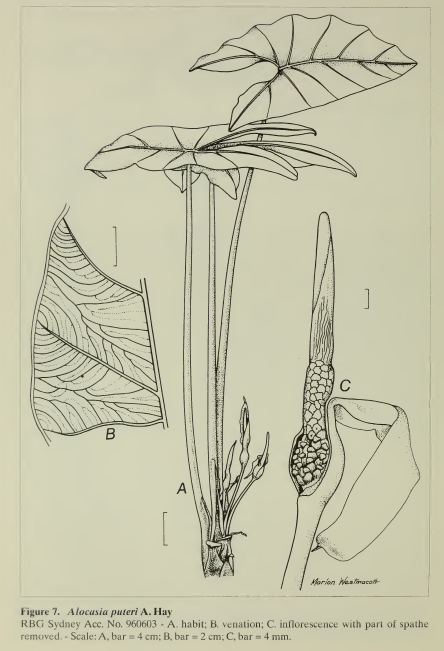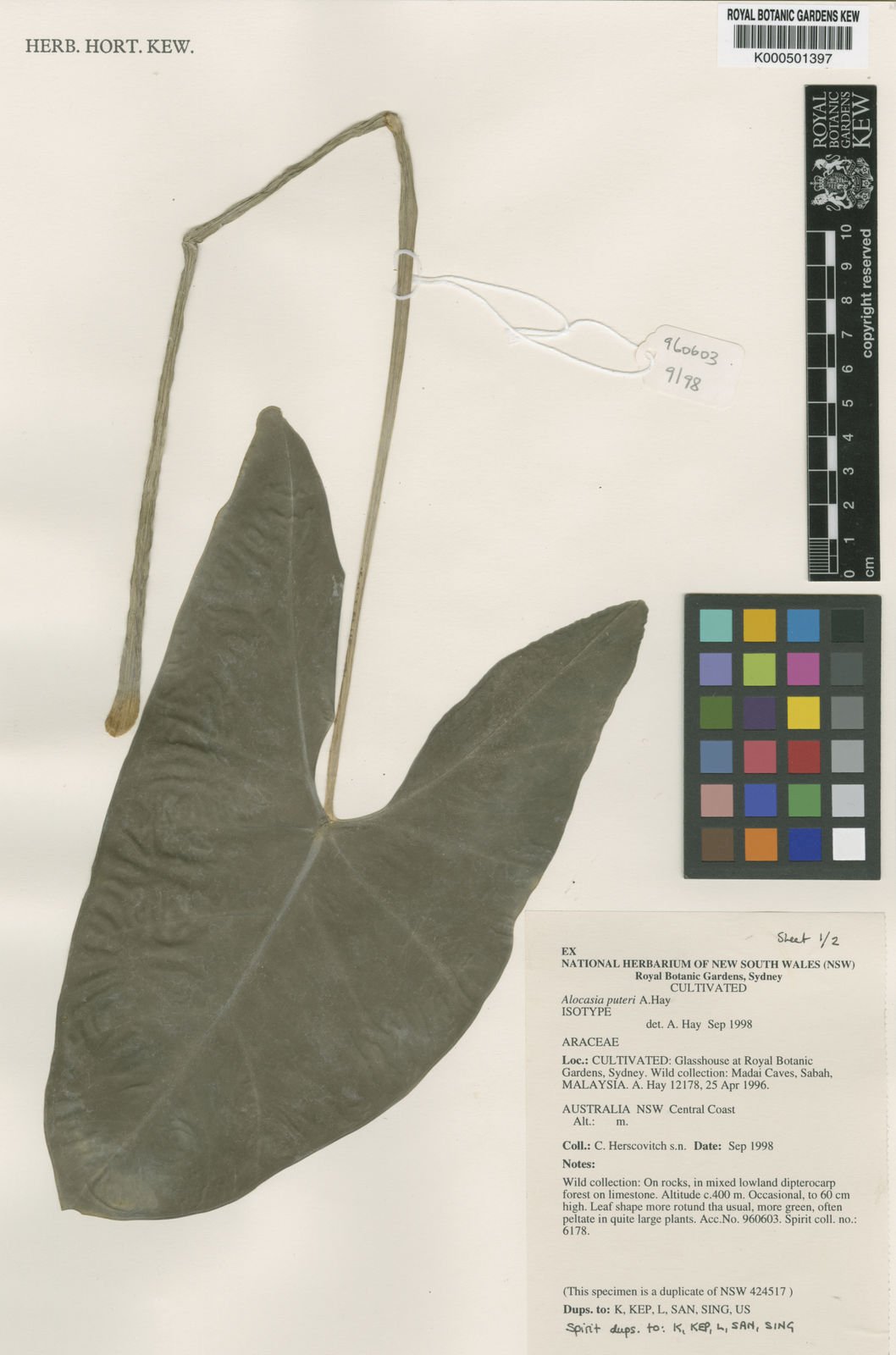ALOCASIA PUTERI
ORIGINAL DESCRIPTION:
Ab Alocasia pangeran A. Hay lamina folii claro-viride, lobis posticis intus ovatis, inflorescentia breviori, interstitio neutro brevissimo crasso vel nullo, inflorescentia mascula minus exserta, stigmate trilobato differt.
TYPUS: Cult. RBG Sydney Acc. No. 960603 ex Malaysia, Sabah, Lahad Datu, Madai Caves, Hay et al 12178 (NSW, holo; iso, K, KEP, L, SAN, SING -to be distributed).
SYNONYMS: N/A
DISTRIBUTION: Malaysian Borneo, endemic to Sabah, known only from Madai Caves where it is uncommon
CLIMATE: Tropical humid climate
Humidity is moderate throughout the year, ranging from 60% to 70%
Temperature is varies between the seasons - within the range of 48°F/9°C to 88°F/31°C during the day. Minimum temperatures never dip below 45°F/7°C
Rainy and humid season (October to May) and a dry season between June and October. The average annual rainfall is 1,200 mm
ECOLOGY: In soil pockets on limestone outcrops and boulders in mixed lowland dipterocarp forest, at ca. 400 m altitude.
SPECIES DESCRIPTION:
Lithophytic herb to ca. 60 cm tall; rhizome ca. 3 cm diam.; leaves ca. 3 together; petioles more or less erect, to ca. 50 cm long, bright green, very faintly mottled shghtly darker green, sheathing in the lower 1/6; blades hastato-sagittate to slightly ovato-sagittate, ca. 30 cm long, bright green adaxially, somewhat paler abaxially, thinly leathery; anterior lobe widest at or shghtly above the base, the apex acute to obtuse and apiculate for ca. 1 cm; anterior costa with 2-3 primary lateral veins on each side diverging at 45-70°; axillary glands very inconspicuous; secondary venation flush with the lamina on both surfaces, faint, forming poorly defined interprimary collective veins in the outer part of the blade; posterior lobes acute, more or less equalling the anterior, the inner sides ovate, peltate even in subadult plants but eventually free; posterior costae naked in the sinus for ca. 2 cm, diverging at ca. 60°
INFLORESCENCE:
Inflorescences ca. 4 together; cataphylls lanceolate, to ca. 7 cm long; peduncles exserted, to 15 cm long; spathe ca. 8 cm long, constricted 2 cm from the base; lower spathe ovoid, greenish ivory; limb lanceolate, green; spadix subequalling the spathe, minutely stipitate; female zone ca. 6 mm long; pistils subglobose, ca. 2 mm diam., pale greenish ivory, more or less outward-facing; style short, ca. 0.5 mm, sharply differentiated from the ovary and stigma; stigma (2-)3-lobed; sterile interstice more or less lacking, the male zone adjunct to the female with some of the lowermost synandria incompletely fertile, or one to two whorls of close-packed synandrodia resembling the synandria, not or hardly attenuated; male zone ivory, cylindric, ca. 1.8 cm long ca. 4 mm diam., 2/3 within the lower spathe chamber, somewhat constricted level with the spathe constriction; synandria rhombo-hexagonal, ca. 2 mm diam., the thecae not overtopped by synconnective; appendix ivory, basally isodiametric with male zone, tapering; infructescence unknown.
VARIEGATED FORMS: N/A
ETYMOLOGY: The specific epithet ‘puteri’, Malay for 'princess', alludes to the relationship with Alocasia princeps and to this species' coexistence with Alocasia pangeran
NOTES:
Alocasia puteri occurs together with and in the same habitat as Alocasia pangeran. They can be differentiated by the former's bright green leaf colour (unusual for this entire species group) vs darker green, the broader posterior lobes, more upright petiole, tendency for the leaves to be peltate in sub-adult plants, virtually lacking sterile interstice of the apendix vs a long partially naked interstice of lax synandrodia, and the stigma being usually 3-lobed vs generally 2-lobed. Moreover, at the time of original collecting both of these species at Madai Caves, plants of Alocasia pangeran were extensively in fruit, while no plants of Alocasia puteri were in either flower or fruit, suggesting they may be isolated by flowering time.
CULTIVARS: N/A
HYBRIDS: N/A





